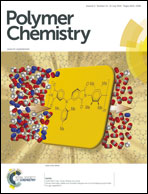Complex thermoresponsive behavior of diblock polyacrylamides†
Abstract
Diblock thermoresponsive copolymers poly(N-n-propylacrylamide)-b-poly(N,N-ethylmethylacrylamide) (PnPA-b-PEMA) of various block lengths were synthesized by sequential reversible addition–fragmentation chain transfer (RAFT) polymerization. The work aims at understanding the complex thermoresponsive behavior of block copolymers whose aqueous solutions change, with increasing temperature, from a transparent solution to a cloudy and then to a clear and finally to a turbid liquid. The thermoresponsive behavior depends on the polymer concentration and is reversible with certain hysteresis. Dynamic light scattering and atomic force microscopy results help to assign the first cloud point to a transition from unimers to micellar clusters. The longer PnPA block relative to the PEMA block and the hydrogen bonding between the PnPA and PEMA blocks are determining forces for the formation of micellar clusters. Further rise in temperature leads to restructuring and dissociation of these loose clusters into smaller micelles due to further dehydration of the PnPA block and disruption of hydrogen bonds between the PnPA and PEMA blocks, resulting in an optically clear solution. A second cloud point appears again when the micelles start to aggregate. A pseudo-phase diagram was obtained for N-substituted polyacrylamides, providing guidelines towards the rational design of thermoresponsive copolymers showing two or more responsive temperatures.


 Please wait while we load your content...
Please wait while we load your content...